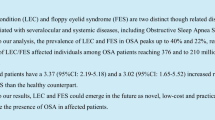Abstract
Floppy eyelids are usually asymmetrical, and more severe on the side the patient sleeps on. This has been related to the mechanical basis of this entity’s pathophysiology. Patients who exhibit floppy eyelid syndrome (FES) tend to suffer from obstructive sleep apnea and other sleeping disorder such as snoring; therefore, their spouses are likely to be found sleeping facing away from them. In this study, we aim to assess this correlation between FES laterality and the spouse’s sleeping side. 185 patients with floppy eyelid were assessed. Upper lids were pulled cephalad towards the orbital rim to assess which side everted and was more floppy. Based on the upper lid distraction test, a prediction was made to which side of the bed the spouse slept on. 185 patients with floppy eyelid syndrome were assessed, 160 male patients and 25 females, at an average age of 68. All 25 female patients, and 117 of the male patients, had spouses that slept in the same bed. Their side of sleep was predicted correctly in 87% of cases. The physician extrapolated the spouse slept on the opposite side facing away from the snoring spouse and was correct in 91% of cases. There is a high correlation between FES laterality and the patient’s spouse’s sleeping side. These data strengthen the mechanical etiology, and can also be used to confirm the worse-affected side in FES patients.



Similar content being viewed by others
References
Culbertson WW, Ostler HB. The floppy eyelid syndrome. Am J Ophthalmol. 1981;92(4):568–75.
McNab AA. The eye and sleep apnea. Sleep Med Rev. 2007;11(4):269–76.
Ezra DG, Beaconsfield M, Sira M, Bunce C, Wormald R, Collin R. The associations of floppy eyelid syndrome: a case control study. Ophthalmology. 2010;117(4):831–8.
Yeung AM, Ashfaq I, Ghosh YK, Kyprianou I, Ahluwalia HS. Floppy eyelid syndrome: the coventry experience. Orbit. 2014;33(6):399–405.
Leibovitch I, Selva D. Floppy eyelid syndrome: clinical features and the association with obstructive sleep apnea. Sleep Med. 2006;7(2):117–22.
Idowu OO, Ashraf DC, Vagefi MR, Kersten RC, Winn BJ. Floppy eyelid syndrome: ocular and systemic associations. Curr Opin Ophthalmol. 2019;30:513–24.
Tanenbaum M. A rational approach to the patient with floppy/lax eyelids. Br J Ophthalmol. 1994;78(9):663–4.
van den Bosch WA, Lemij HG. The lax eyelid syndrome. Br J Ophthalmol. 1994;78(9):666–70.
Fowler AM, Dutton JJ. Floppy eyelid syndrome as a subset of lax eyelid conditions: relationships and clinical relevance (an ASOPRS Thesis). Ophthalmic Plast Reconstr Surg. 2010;26(3):195–204.
Fox TP, Schwartz JA, Chang AC, Parvin-Nejad FP, Yim CK, Feinsilver SH, Wu AY. Association between eyelid laxity and obstructive sleep apnea. JAMA Ophthalmol. 2017;135(10):1055–61.
Sward M, Kirk C, Kumar S, Nasir N, Adams W, Bouchard C. Lax eyelid syndrome (LES), obstructive sleep apnea (OSA), and ocular surface inflammation. Ocul Surf. 2018;16(3):331–6.
Kadyan A, Asghar J, Dowson L, Sandramouli S. Ocular findings in sleep apnoea patients using continuous positive airway pressure. Eye (London). 2010;24(5):843–50.
Netland PA, Sugrue SP, Albert DM, Shore JW. Histopathologic features of the floppy eyelid syndrome: involvement of tarsal elastin. Ophthalmology. 1994;101(1):174–81.
Schlötzer-Schrehardt U, Stojkovic M, Hofmann-Rummelt C, Cursiefen C, Kruse FE, Holbach LM. The Pathogenesis of floppy eyelid syndrome: involvement of matrix metalloproteinases in elastic fiber degradation. Ophthalmology. 2005;112(4):694–704.
McNab AA. Floppy eyelid syndrome and obstructive sleep apnea. Ophthalmic Plast Reconstr Surg. 1997;13(2):98–114.
Liu DT, Di Pascuale MA, Sawai J, Gao YY, Tseng SC. Tear film dynamics in floppy eyelid syndrome. Invest Ophthalmol Vis Sci. 2005;46(4):1188–94.
Woog JJ. Obstructive sleep apnea and the floppy eyelid syndrome. Am J Ophthalmol. 1990;110(3):314–5.
Muniesa MJ, Huerva V, Sánchez-de-la-Torre M, Martínez M, Jurjo C, Barbé F. The relationship between floppy eyelid syndrome and obstructive sleep apnoea. Br J Ophthalmol. 2013;97(11):1387–90.
Lee CC, Lai HT, Kuo YR, Lee SS, Lai CS. Floppy eyelid syndrome: an unfamiliar entity for plastic surgeons. Ann Plast Surg. 2018;80:S40–7.
Wang P, Yu DJ, Feng G, Long ZH, Liu CJ, Li H, Zhao TL. Is floppy eyelid syndrome more prevalent in obstructive sleep apnea syndrome patients? J Ophthalmol. 2016;2016:6980281. https://doi.org/10.1155/2016/6980281.
Karger RA, White WA, Park WC, Rosales AG, McLaren JW, Olson EJ, Woog JJ. Prevalence of floppy eyelid syndrome in obstructive sleep apnea-hypopnea syndrome. Ophthalmology. 2006;113(9):1669–74.
Chambe J, Laib S, Hubbard J, Erhardt C, Ruppert E, Schroder C, Malan A, Bourcier T, Bourgin P. Floppy eyelid syndrome is associated with obstructive sleep apnoea: a prospective study on 127 patients. J Sleep Res. 2012;21(3):308–15.
McNab AA. Reversal of floppy eyelid syndrome with treatment of obstructive sleep apnoea. Clin Exp Ophthalmol. 2000;28(2):125–6.
Porta R, Comini L, Barbano L, Bianchi L, Vitacca M. A case of obstructive sleep apnea syndrome associated with floppy eyelid syndrome: positive effect of CPAP therapy. Monaldi Arch Chest Dis. 2017;87(1):766.
Acknowledgements
No financial support was granted. IRB permission 0327-19-ASF
Funding
The authors have no financial interests to disclose.
Author information
Authors and Affiliations
Corresponding author
Ethics declarations
Conflict of interest
On behalf of all authors, the corresponding author states that there is no conflict of interest.
Additional information
Publisher's Note
Springer Nature remains neutral with regard to jurisdictional claims in published maps and institutional affiliations.
Rights and permissions
About this article
Cite this article
Stein, R., Fezza, J.P., Harrison, A.R. et al. Floppy eyelids: sleeping patterns of spouses as indicators of laterality. Sleep Biol. Rhythms 19, 63–67 (2021). https://doi.org/10.1007/s41105-020-00288-4
Received:
Accepted:
Published:
Issue Date:
DOI: https://doi.org/10.1007/s41105-020-00288-4




